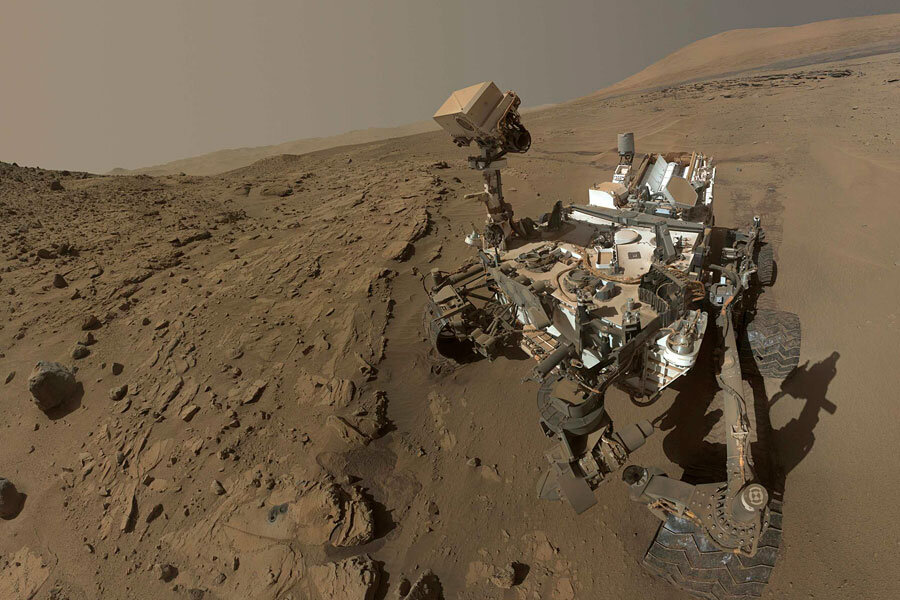Was Mars once cold and wet? Scientists see evidence of Mt. Sharp glaciers
Well before NASA's Mars rover Curiosity clocked its first Martian birthday this week, the robotic geologist uncovered strong evidence that liquid water – a key ingredient for organic life – once flowed across and pooled on the floor of Gale Crater, the rover's field site.
Now, an international team of planetary scientists says it has identified evidence for a potential source for that ancient water: glaciers that flowed down the slopes of Mt. Sharp, a 60-mile-wide mound that vaults some 18,000 feet from the crater floor.
If the team's analysis holds up, it could suggest that early Mars may have been neither warm and wet nor cold and dry, but cold and wet, suggests Cornell University planetary scientist Alberto Fairén, who led the group.
The evidence comes from a close study of exquisitely detailed images of Mt. Sharp beamed back by NASA's Mars Reconnaissance Orbiter and the European Space Agency's Mars Express orbiter.
Indeed, the researchers note that Curiosity itself could well provide on-the-ground tests of the glacier hypothesis when it reaches Mt. Sharp, formally known as Aeolis Mons. The researchers published their results recently in the journal Planetary and Space Science.
Gale Crater lies in a region just south of the equator and is part of the geological boundary between Mars' southern highlands and northern lowlands. It's a location that would have put it in the path of water on early Mars working its way downhill on a warm, wet planet or one making the transition from warm and wet to cold and dry.
Other researchers have seen evidence for glacial action elsewhere along transition regions from highlands to lowlands, as well as in Gale itself. The glaciers are thought to build and vanish as the planet's climate responds to a pronounced wobble in Mars' axis, whose tilt ranges from 25 degrees to 45 degrees. Every few million years, this wobble brings enough chill to the equatorial region that it snows as polar ice melts to add water vapor to the atmosphere.
Dr. Fairén and colleagues note, however, that Gale Crater formed too late – about 3.8 billion to 3.6 billion years ago – for the features they see to have emerged from earlier geological processes that formed similar-looking features elsewhere. And the crater lacks formations resembling those that testify to more-recent glacial action elsewhere along the transition zone.
In the end, Fairén writes in an e-mail, Gale Crater turned out to be the ideal location to hunt for evidence that would test the cold-wet Mars theory.
"We wanted to analyze a site particularly well studied with orbiters, and also one which is going to be very well known in the near future with ground investigations," he writes. After Curiosity arrived, Gale Crater fit the bill.
Perhaps the most compelling evidence, the team says, comes in the form of three or four particularly pudgy fingers of rocky material, each about half a mile to a little over a mile wide and about 3.7 to 5 miles long. They bear an uncanny resemblance to a rock glacier found in a valley in Alaska's Chugach Mountains, east of Anchorage.
Rock glaciers represent either flowing ice with a high rock content, or a glacier that has been covered with debris from rock slides as it grinds its way down a valley. These major lobes originate high up the mountain and stop well short of the base. And they are overlain near their source region by what appear to be additional, smaller lobes.
In addition, the mountain shows features that closely resemble drumlins, mounds of glacially ground soil a glacier builds ahead of it when it surges, then retreats. The team allows, however, that these features also could have resulted from a build-up of windblown Martian soil.
Working their way downslope, the team also spots what could be a terminal moraine – a lateral rise in the landscape where a glacier stopped bulldozing material and began its retreat.
And they observed a range of other features, including sharp-cut canyons with steep walls at the upslope end, gullies, and evidence for periodically rejuvenated rivers that could have formed through glacial meltwater.
The researchers readily acknowledge that the case for glacial activity – and by extension a cold, wet Mars – is far from ironclad. But they note that as Curiosity explores the base of Mt. Sharp, its final destination, it has all the right tools to reveal the look and chemistry of the rocks there.
For instance, boulders whose faces end in sharp or only slightly dulled edges would provide evidence of the action of glaciers, as would abrasion marks on boulders. Finding minerals that form in the presence of water, especially if they are similar to or the same as minerals Curiosity has uncovered on the crater floor, could provide additional clues.
So far, the team's modeled scenario for glaciers, surface features that would form in the presence of ice or permafrost, and rivers and ponds of very cold water on Gale between 3.7 billion and 2 billion years ago "is totally consistent with the published evidence of water Curiosity has found so far," Fairén says.








